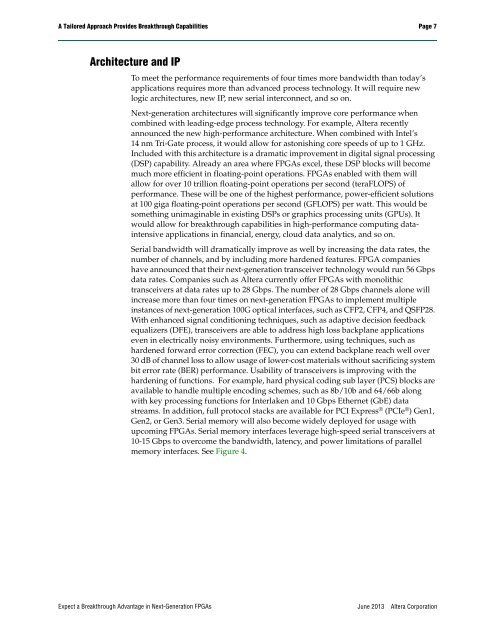Expect a Breakthrough Advantage in Next-Generation FPGAs - Altera
Expect a Breakthrough Advantage in Next-Generation FPGAs - Altera
Expect a Breakthrough Advantage in Next-Generation FPGAs - Altera
Create successful ePaper yourself
Turn your PDF publications into a flip-book with our unique Google optimized e-Paper software.
A Tailored Approach Provides <strong>Breakthrough</strong> Capabilities Page 7<br />
Architecture and IP<br />
To meet the performance requirements of four times more bandwidth than today’s<br />
applications requires more than advanced process technology. It will require new<br />
logic architectures, new IP, new serial <strong>in</strong>terconnect, and so on.<br />
<strong>Next</strong>-generation architectures will significantly improve core performance when<br />
comb<strong>in</strong>ed with lead<strong>in</strong>g-edge process technology. For example, <strong>Altera</strong> recently<br />
announced the new high-performance architecture. When comb<strong>in</strong>ed with Intel’s<br />
14 nm Tri-Gate process, it would allow for astonish<strong>in</strong>g core speeds of up to 1 GHz.<br />
Included with this architecture is a dramatic improvement <strong>in</strong> digital signal process<strong>in</strong>g<br />
(DSP) capability. Already an area where <strong>FPGAs</strong> excel, these DSP blocks will become<br />
much more efficient <strong>in</strong> float<strong>in</strong>g-po<strong>in</strong>t operations. <strong>FPGAs</strong> enabled with them will<br />
allow for over 10 trillion float<strong>in</strong>g-po<strong>in</strong>t operations per second (teraFLOPS) of<br />
performance. These will be one of the highest performance, power-efficient solutions<br />
at 100 giga float<strong>in</strong>g-po<strong>in</strong>t operations per second (GFLOPS) per watt. This would be<br />
someth<strong>in</strong>g unimag<strong>in</strong>able <strong>in</strong> exist<strong>in</strong>g DSPs or graphics process<strong>in</strong>g units (GPUs). It<br />
would allow for breakthrough capabilities <strong>in</strong> high-performance comput<strong>in</strong>g data<strong>in</strong>tensive<br />
applications <strong>in</strong> f<strong>in</strong>ancial, energy, cloud data analytics, and so on.<br />
Serial bandwidth will dramatically improve as well by <strong>in</strong>creas<strong>in</strong>g the data rates, the<br />
number of channels, and by <strong>in</strong>clud<strong>in</strong>g more hardened features. FPGA companies<br />
have announced that their next-generation transceiver technology would run 56 Gbps<br />
data rates. Companies such as <strong>Altera</strong> currently offer <strong>FPGAs</strong> with monolithic<br />
transceivers at data rates up to 28 Gbps. The number of 28 Gbps channels alone will<br />
<strong>in</strong>crease more than four times on next-generation <strong>FPGAs</strong> to implement multiple<br />
<strong>in</strong>stances of next-generation 100G optical <strong>in</strong>terfaces, such as CFP2, CFP4, and QSFP28.<br />
With enhanced signal condition<strong>in</strong>g techniques, such as adaptive decision feedback<br />
equalizers (DFE), transceivers are able to address high loss backplane applications<br />
even <strong>in</strong> electrically noisy environments. Furthermore, us<strong>in</strong>g techniques, such as<br />
hardened forward error correction (FEC), you can extend backplane reach well over<br />
30 dB of channel loss to allow usage of lower-cost materials without sacrific<strong>in</strong>g system<br />
bit error rate (BER) performance. Usability of transceivers is improv<strong>in</strong>g with the<br />
harden<strong>in</strong>g of functions. For example, hard physical cod<strong>in</strong>g sub layer (PCS) blocks are<br />
available to handle multiple encod<strong>in</strong>g schemes, such as 8b/10b and 64/66b along<br />
with key process<strong>in</strong>g functions for Interlaken and 10 Gbps Ethernet (GbE) data<br />
streams. In addition, full protocol stacks are available for PCI Express ® (PCIe ® ) Gen1,<br />
Gen2, or Gen3. Serial memory will also become widely deployed for usage with<br />
upcom<strong>in</strong>g <strong>FPGAs</strong>. Serial memory <strong>in</strong>terfaces leverage high-speed serial transceivers at<br />
10-15 Gbps to overcome the bandwidth, latency, and power limitations of parallel<br />
memory <strong>in</strong>terfaces. See Figure 4.<br />
<strong>Expect</strong> a <strong>Breakthrough</strong> <strong>Advantage</strong> <strong>in</strong> <strong>Next</strong>-<strong>Generation</strong> <strong>FPGAs</strong><br />
June 2013<br />
<strong>Altera</strong> Corporation
















